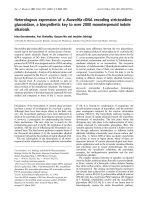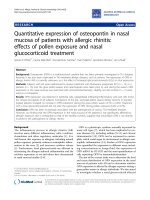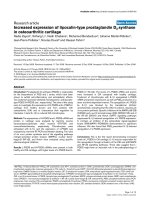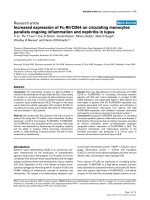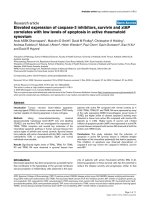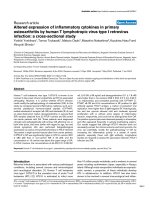Báo cáo y học: "Quantitative expression of osteopontin in nasal mucosa of patients with allergic rhinitis: effects of pollen exposure and nasal glucocorticoid treatment" pdf
Bạn đang xem bản rút gọn của tài liệu. Xem và tải ngay bản đầy đủ của tài liệu tại đây (1.03 MB, 4 trang )
RESEA R C H Open Access
Quantitative expression of osteopontin in nasal
mucosa of patients with allergic rhinitis:
effects of pollen exposure and nasal
glucocorticoid treatment
Serena E O’Neil
1*
, Carina Malmhäll
1
, Konstantinos Samitas
2
, Teet Pullerits
1
, Apostolos Bossios
1
, Jan Lötvall
1
Abstract
Background: Osteopontin (OPN) is a multifunctional cytokine that has been primarily investigated in Th1 diseases.
Recently, it has also been implicated in Th2-mediated allergic diseases, such as asthma. The expression of OPN in
allergic rhinitis (AR) is currently unknown, as is the effect of intranasal glucocorti costeroids (GCs) on that expression.
Methods: Subjects with AR were randomised to receive treatment with fluticasone propionate (FP) (n = 12) or a
placebo (n = 16) over the grass pollen season and nasal biopsies were taken prior to, and during the season. OPN
expression in the nasal mucosa was examined with immunohistochemistry. Healthy non-AR controls (n = 5) were
used as a comparator.
Results: OPN expression was detected in epithelial cells, subepithelial infiltrating/inflammatory cells and cells lining
the vessels and glands of all subjects. Comparison of the pre- and peak-pollen season biopsy sections in placebo
treated patients revealed no increase in OPN expression during the grass pollen season (5.7% vs 6.4%). Treatment
with a local glucocorticosteroid did not alter the expression of OPN during pollen exposure (6.2% vs 6.7%).
Conclusion: OPN has been increasingly associated with the pathogenesis of various Th2-mediated diseases.
However, our finding that the OPN expression in the nasal mucosa of AR patients is not significantly affected by
allergen exposure and is comparable to that of the healthy controls, suggests that intracellular OPN is not directly
involved in the pathogenesis of allergic rhinitis.
Background
The inflammatory process in allergic rhinitis (AR)
involves many different inflammatory cells, cytokines,
chemokines and other regulatory molecules [1]. It is
well known that exposure to allergens, including natural
pollen exposure, primarily enhances eosinophilic inflam-
mation in the nose [2] and increases cytokine release
[1]. Furthermore, local glucocorticoids are efficient in
attenuating the allergen-induced inflammation and the
cytokine expression, as we and others have documented
in nasal mucosal studies [2-6].
OPN is a pleiotropic cytokine normally expressed by
many cell types [7], which has been implicated in var-
ious diseases [8], including asthma [9-11] and chronic
rhinosinusitis [12]. OPN can be expressed in eosino-
phils, which could argue its involvement in allergic eosi-
nophilic inflammation [13]. Studies of OPN expression
have quantified the expression in different ways, includ-
ing concentrations in lavage fluid, the expression of
OPN mRNA by RT-PCR and the semi-quantification of
cells expressing OPN by immunohistochemistry.
The aim of the current study was to determine the level
and tissue dist ribution of OPN expression in the nasal
mucosa of pat ients with AR and to determine whether
OPN expression is affected by allergen exposu re during a
grass pollen se ason in allergic individuals. We also aimed
to investigate whether a nasal gluc ocorticoid affected
* Correspondence:
1
Krefting Research Centre, Sahlgrenska Academy, University of Gothenburg,
Sweden
Full list of author information is available at the end of the article
O’Neil et al. Allergy, Asthma & Clinical Immunology 2010, 6:28
/>ALLERGY, ASTHMA & CLINICAL
IMMUNOLOGY
© 2010 O’Neil et al; licensee BioMed Central Ltd. This is an Open Access article distributed under the terms of the Creative Commons
Attribution License ( which permits unrestricted use, distribution, and reproduction in
any medium, provided the original wor k is properly cited.
local OPN expression. The nasal biopsies used in the cur-
rent study have previously been evaluated in other
studies showing clear clinical effects of pollen exposure,
as well as effects of a nasal glucocorticoid treatment on
both symptoms of rhinitis, eosinophilia and expression of
several cytokines [2,5].
Materials and methods
Nasal biopsy samples were obtained as a part of a pre-
viously published clinical study [2]. Briefly, grass pollen
sensitised allergic rhinitis (AR) subjects were randomised
to receive the intranasal glucocorticocoid, fluticasone
propionate (FP) (200 μg/day) (n = 12; median age 30.5,
range 18-40 years) or placebo (n = 16; median age 30,
range 16-48 years) for the duration of the grass pollen
season, sta rting approxi mately 2 weeks before the
expected onset. The nasal biopsies were collected 1-2
months before the commencement of treatment and at
the peak of the season. Ethics approval was obtained
from the Ethics Review Committee of Clinical Research
Studies at the University of Tartu, Estonia. Written
informed consent was provided by all participants. As
controls, nasal biopsies were taken from five healthy,
non-allergic individuals prior to the pollen season [5].
Nasal biopsy sections were immersed in OCT com-
pound in cryomoulds (Tissue-Tek, Sakura Finetek
Europe, Zoeterwouede, Netherlands), snap frozen in
liquid nitrogen and stored at -80°C prior to processing.
Tissue sections of 5 μm thickness were prepared,
wrapped in aluminium foil and stored at -80˚C. Thawed
sections were fixed in 2% formaldehyde and treated with
pre-heated PBS containing 0.0064% sodium azide, 0.18%
glucose, 0.1% saponin, 1:3750 glucose oxidase, for
40 mins to inhibit endogenous peroxidise. Unspecific
binding was blocked for 30 mins using 10% rabbit
serum (DAKO Denmark A/S, Denmark). Sections were
incubated with mouse anti-osteopontin monoclonal
antibody (clone 190312. MAB1433) (R&D Systems, Inc.
MN, USA) for 2 hrs, followed by incub ation with a sec-
ondary antibody (peroxidase conjugated rabbit F(ab’)
2
anti-mouse IgG (Zymed Laboratories, CA, USA)). The
positive staining was detected using the Liquid DAB
Substrate-Chromogen System (D AKO), followed by
counterstaining with Mayers Hematoxylin (Sigma-
Aldrich, MO, USA) A matched isotype control, mouse
IgG
2B
(clone 20116, MAB004) (Sigma), was used at the
same concentration a s the primary antibody. Represen-
tative pictures were recorded prior to destaining the
slides of hematoxylin with 1% HCl in 70% ethanol.
The hematoxylin destained samples were assessed in a
blinded fashion using a Leica DC 300F microscope
(Leica Microsystems GmbH, Germany) at a magnifica-
tion of ×200. The positively stained area of the e ntire
tissue section was determined using quantitative imaging
software (Leica QWin) with the same threshold used for
all sections. The data was expressed as a percentage of
total tissue area.
GraphPad 5 (GraphPad Software, Inc. CA, USA) was
used for the non-parametric statistical analysis of the per-
centage of positive staining in tissues. A Mann Whitney
test was used to compare the controls with the patient
groups and to compare the changes (Δ change) between
the 2 patient groups over the season. The Wilcoxon
signed rank test was used to compare the changes over
the season. A P value of < 0.05 was considered statisti-
cally significant. The data are presented in a scatter plot
with mean and SEM of the treatment group.
Results
Immunohistochemistry revealed clear expression of intra-
cellular OPN in epithelial cells (Figure 1A) and vascular,
as well as submucosal gland (Figure 1B) endothelial cells.
In mo st cells, the most prominent st aining was observed
in the nuclei. The most intense staining was observe d in
epithelial and endothelial cells, but also in the subepithelial
layer to a lesser extent.
Previous studies on these nasal biopsies have shown a
clear increase in the number of EG2
+
cells over the pollen
season and no increase with FP treatment. To determine if
the expression of OPN is related to the change in eosino-
phil numbers previously seen in the AR nasal biopsies, the
staining was compared to the EG2
+
cell counts previously
obtained [2]. T he cellular location of the EG2
+
staining
was distinctly different to that of the OPN staining (data
not shown). Additionally, no correlation between the
EG2
+
cell counts (epithelium or subepithelium) and OPN
staining was observed (Spearman R 0.049-0.274).
The mean OPN expression (% area) was similar in
nasal biopsies from healthy controls (4.1 ± 0.8%) com-
pared to pre-season patient samples (5.9 ± 0.4%; p =
0.0706). During the grass pollen season, no significant
change in OPN expression was seen in AR patients trea-
tedwithplaceboorFP(Figure2).Comparisonofthe
difference in OPN expres sion induced by the grass pol-
len season revealed no difference between the placebo
and FP treated patient groups (p = 0.82).
Discussion
There is an increased scientific interest in the putative
role of OPN in several diseases, including asthma, allergy
and rhinosinusitis [7,10,14,15]. In the current study, we
have observed clear expression of OPN in the nasal
mucosa of both healthy individuals and patients with AR.
Natural exposure to pollen did not, however, change the
expression of OPN in patients treated with placebo.
Lastly, local treatment with a potent nasal glucocorticoid,
did not affect the OPN expression in patients with AR
during natural exposure to pollen.
O’Neil et al. Allergy, Asthma & Clinical Immunology 2010, 6:28
/>Page 2 of 4
While OPN is known to be produced by epithelial and
endothelial cells in other healthy tissues [7], our data pro-
vides the first example of the distribution in the nasal
mucosa of AR patients. The expression of OPN protein in
the nasal mucosa of healthy and AR subjects was predomi-
nantly in the nucleus of the epithelial and endothelial cells
(glandular and vesicular). Similarly, OPN expression has
also been seen intracellularly in other nasal bio psies [12],
as well as bronchial biopsies [10,11,16].
OPN has been seen to be expressed as a secreted form
(s-OPN) and an intracellular form. The s-OPN is com-
monly measured in differe nt culture supernatants or
body fluids. It is extensively modified post-translationally
and acts like a Th1 cytokine. Intracellular OPN i s less
well characterised and has been reported as a transla-
tional alternative to s-OPN. It has been shown to be
involved in the modulation of cytoskeletal processes [17]
as well as in the induction of IFN-a in plasmacytoid
dendritic cells [18].
A previous study of the nasal biopsies reported here,
looking at the expression of eosinophils [2], showed a
clear increase in EG2
+
cell numbers induced by a pollen
season, which was inhibited with the use of FP. Eosino-
phils h ave recently been discussed in relation to OPN
[10,13] and as such, the correlation between OPN staining
and EG2
+
cell numbers was analysed. However, the
increase in EG2
+
cell numbers induced by season was not
mirrored with an increase in OPN expression, confirming
that eosinophils are not the only cells producing OPN.
This study shows for the first time that the expression
of OPN in the cells of the nasal mucosa of AR patients
does not increase over a natural pollen season, although
an increase in several cytokines and cells in the nasal
mucosa over the pollen season has been reported [2,5,6].
The scope of this study is limited to the intracellular
expression of OPN in the nasal mucosa of AR patient s. It
should be emphasised that although no differences in
intracellular OPN expression were observed, this may not
Figure 1 Immunostaining for osteopontin in nasal biopsies. Representative pictures of immunostaining for osteopontin in nasal biopsies of
allergic rhinitis patients (peak-season, placebo treated) (×400) in epithelium (A) and glands (B). Arrows indicate OPN staining.
Figure 2 Percentage of osteopontin stained area in nasal
biopsies pre- and peak season. The percentage of the
osteopontin stained area in pre- and peak-season nasal biopsies of
allergic rhinitis (AR) patients treated with placebo (P) or fluticasone
propionate (FP). The mean and SEM is indicated per group.
O’Neil et al. Allergy, Asthma & Clinical Immunology 2010, 6:28
/>Page 3 of 4
be the case for s-OPN. The expression of OPN in the
nasal lavage fluid of AR patients should be measured to
determine if soluble OPN expression is changed by natural
poll en exposure or glucocortico ids. In the lower airways,
Takahashi et al [10] found that although there was no dif-
ference in intracellular OPN expression in the lung, there
was a significant increase in the sputum OPN levels
between asthmatic and healthy subjects. Conversely,
Xanthou et al [11] reported an increased intracellular
OPN expression in asthmatics, compared to healthy
subjects.
It has been previously seen that glucocorticoids are
quite effective in inhibiting both the expression of
inflammatory cells and clinical symptoms [3] induced by
the pollen season. It has previously been shown that
FOXP3, GATA-3 [5] and EG2
+
cells [2] in the nasal
mucosa of AR patients increase during the pollen season
and that their expression is suppressed by the nasal glu-
cocorticosteroid FP. Unlike the previous biopsy studies
and murine studies [14] the expression of OPN was not
inhibited by treatment with FP. This lack of inhibition
of OPN expression has also been observed in the serum,
bronchial tissue and bronchoalveolar lavage fluid of
asthmatics [16]. Erin et al [3] has previously shown that
FP is effective in inhibiting Th2, but not Th1, cytokine
synthesis. OPN has been suggested to act as both a Th1
and Th2 cytokine [8]. The lack of effect by FP on the
OPN in the nasal mucosa could suggest that intracellu-
lar OPN has a Th1-like role in the nasal mucosa of AR.
Conclusions
In conclusion, despite the large role that OPN plays in
many diseases, including Th2 diseases, like asthma,
OPN in allergic rhinitis has been shown here to not be
directly involved in the nasal mucosa changes over the
pollen season, or in the response to glucocorticoid treat-
ment. This suggests that intracellular OPN in A R
patients cannot be used as a marker of disease.
Acknowledgements
We would like to acknowledge the assistance of Julia Fernandez-Rodriguez
and Esbjörn Telemo for their expert advice and use of equipment. We
would like to thank Margareta Sjöstrand for proofing the manuscript.
Author details
1
Krefting Research Centre, Sahlgrenska Academy, University of Gothenburg,
Sweden.
2
7th Respiratory Department, Athens Chest Hospital (“Sotiria”),
Greece.
Authors’ contributions
SO performed the immunohistochemistry and analyses, and drafted the
manuscript. KS and CM helped in design of experiment . AB and JO
conceived of the study. JO and KS helped draft the manuscript. TP provided
the data from a previous eosinophils study. All authors read and approved
the final manuscript.
Competing interests
The authors declare that they have no competing interest s.
Received: 17 June 2010 Accepted: 2 November 2010
Published: 2 November 2010
References
1. Skoner DP: Allergic rhinitis: definition, epidemiology, pathophysiology,
detection, and diagnosis. J Allergy Clin Immunol 2001, 108:S2-8.
2. Pullerits T, Praks L, Ristioja V, Lotvall J: Comparison of a nasal
glucocorticoid, antileukotriene, and a combination of antileukotriene
and antihistamine in the treatment of seasonal allergic rhinitis. J Allergy
Clin Immunol 2002, 109:949-955.
3. Erin EM, Zacharasiewicz AS, Nicholson GC, Tan AJ, Higgins LA, Williams TJ,
Murdoch RD, Durham SR, Barnes PJ, Hansel TT: Topical corticosteroid
inhibits interleukin-4, -5 and -13 in nasal secretions following allergen
challenge. Clin Exp Allergy 2005, 35:1608-1614.
4. Holm A, Dijkstra M, Kleinjan A, Severijnen LA, Boks S, Mulder P, Fokkens W:
Fluticasone propionate aqueous nasal spray reduces inflammatory cells
in unchallenged allergic nasal mucosa: effects of single allergen
challenge. J Allergy Clin Immunol 2001, 107:627-633.
5. Malmhall C, Bossios A, Pullerits T, Lotvall J: Effects of pollen and nasal
glucocorticoid on FOXP3+, GATA-3+ and T-bet+ cells in allergic rhinitis.
Allergy 2007, 62:1007-1013.
6. Sergejeva S, Malmhall C, Lotvall J, Pullerits T: Increased number of CD34+
cells in nasal mucosa of allergic rhinitis patients: inhibition by a local
corticosteroid. Clin Exp Allergy 2005, 35:34-38.
7. Kunii Y, Niwa S, Hagiwara Y, Maeda M, Seitoh T, Suzuki T: The
immunohistochemical expression profile of osteopontin in normal
human tissues using two site-specific antibodies reveals a wide
distribution of positive cells and extensive expression in the central and
peripheral nervous systems. Med Mol Morphol 2009, 42:155-161.
8. Lund SA, Giachelli CM, Scatena M: The role of osteopontin in
inflammatory processes. J Cell Commun Signal 2009, 3:311-322.
9. Kohan M, Bader R, Puxeddu I, Levi-Schaffer F, Breuer R, Berkman N:
Enhanced osteopontin expression in a murine model of allergen-
induced airway remodelling. Clin Exp Allergy 2007, 37:1444-1454.
10. Takahashi A, Kurokawa M, Konno S, Ito K, Kon S, Ashino S, Nishimura T,
Uede T, Hizawa N, Huang SK, Nishimura M: Osteopontin is involved in
migration of eosinophils in asthma. Clin Exp Allergy 2009, 39:1152-1159.
11. Xanthou G, Alissafi T, Semitekolou M, Simoes DC, Economidou E, Gaga M,
Lambrecht BN, Lloyd CM, Panoutsakopoulou V: Osteopontin has a crucial
role in allergic airway disease through regulation of dendritic cell
subsets. Nat Med 2007, 13:570-578.
12. Lu X, Zhang XH, Wang H, Long XB, You XJ, Gao QX, Cui YH, Liu Z:
Expression of osteopontin in chronic rhinosinusitis with and without
nasal polyps. Allergy 2009, 64 :104-111.
13. Puxeddu I, Berkman N, Ribatti D, Bader R, Haitchi HM, Davies DE,
Howarth PH, Levi-Schaffer F: Osteopontin is expressed and functional in
human eosinophils. Allergy 2010, 65:168-174.
14. Kurokawa M, Konno S, Matsukura S, Kawaguchi M, Ieki K, Suzuki S, Odaka M,
Watanabe S, Homma T, Sato M, Takeuchi H, Hirose T, Huang SK, Adachi M:
Effects of corticosteroids on osteopontin expression in a murine model
of allergic asthma. Int Arch Allergy Immunol 2009,
149(Suppl 1):7-13.
15. Simoes DC, Xanthou G, Petrochilou K, Panoutsakopoulou V, Roussos C,
Gratziou C: Osteopontin deficiency protects against airway remodeling
and hyperresponsiveness in chronic asthma. Am J Respir Crit Care Med
2009, 179:894-902.
16. Samitas K, Zervas E, Vittorakis S, Semitekolou M, Alissafi T, Bossios A,
Gogos H, Economidou E, Lotvall J, Xanthou G, Panoutsakopoulou V,
Gaga M: Osteopontin expression and relation to disease severity in
human asthma. Eur Respir J 2010.
17. Wang KX, Denhardt DT: Osteopontin: role in immune regulation and
stress responses. Cytokine Growth Factor Rev 2008, 19:333-345.
18. Shinohara ML, Lu L, Bu J, Werneck MB, Kobayashi KS, Glimcher LH,
Cantor H: Osteopontin expression is essential for interferon-alpha
production by plasmacytoid dendritic cells. Nat Immunol 2006, 7:498-506.
doi:10.1186/1710-1492-6-28
Cite this article as: O’Neil et al.: Quantitative expression of osteopontin
in nasal mucosa of patients with allergic rhinitis: effects of pollen
exposure and nasal glucocorticoid treatment. Allergy, Asthma & Clinical
Immunology 2010 6:28.
O’Neil et al. Allergy, Asthma & Clinical Immunology 2010, 6:28
/>Page 4 of 4



